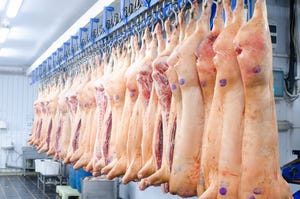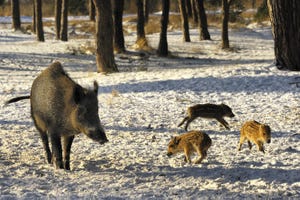U.S. preparedness underway for Japanese encephalitis
Based on the risk assessment, aircraft and cargo ships were the most likely pathways of JEV introduction via infected adult mosquitoes.
November 24, 2022

In February 2022, an outbreak of Japanese encephalitis in Australia drew the attention of pork producers, veterinarians, animal and public health government officials, and allied industries around the world. In the United States, the pork industry began monitoring Australia's situation and response, ramping up preparedness activities immediately. Some of these efforts were shared during a recent symposium hosted by the Center for the Ecology of Infectious Disease at the University of Georgia, sponsored in part by the Swine Health Information Center.
Of those attending virtually or in person, 30 were with USDA-affiliated agencies and Michael Neafsey, One Health Coordinator for USDA APHIS, was an invited speaker. He said the likelihood of JEV being found in the United States is low, however, taken seriously by his agency. If established, substantial human and animal health issues along with significant economic impacts are expected outcomes. As with West Nile virus, eradication would be difficult if not impossible if JEV becomes established. Neafsey said the most likely mechanism for JEV introduction and establishment of infection would be through infected mosquitoes and expressed concern about delayed recognition of infection in livestock due to the disease's non-specific presentation.
Neafsey outlined USDA APHIS Veterinary Services' feral swine sample collection programs and pre-existing relationships with local resources as key to JEV surveillance efforts. Veterinary services staff also have pre-established communications chains.
If suspected, JEV diagnosis will come from virus isolation and molecular tools, according to Neafsey. This process will include sequencing for detection and differentiation of flaviviruses. The National Animal Health Laboratory Network along with the National Veterinary Services Laboratories in Ames, Iowa, and Plum Island, New York, will be instrumental in detection of JEV, should there be an incursion.
Existing USDA response frameworks include FAD preparedness which Neafsey said have been used to successfully detect, control and contain diseases for many years. FAD response plans provide disease specific information and response strategies. Neafsey said USDA's JEV disease response strategy is under review and has been removed from the agency's website as it was outdated.
In conclusion, Neafsey outlined USDA response goals which are to detect control and contain FAD outbreaks as quickly as possible, eradicate the FAD using strategies that stabilize animal agriculture, the food supply, the economy and protect public health and the environment. Goals also include providing science and risk-based approaches and systems to facilitate continuity of business for noninfected animals and noncontaminated animal products.
Examining JEV introduction risk in the United States
Natalia Cernicchiaro, Kansas State University, presented information on the risk of introduction of JEV in the continental United States. She noted that the United States shares similar climate and environmental conditions with countries where JEV is epidemic, that the United States has competent vectors and hosts, and that there has been increased travel and trade to and from JEV-affected regions. These characteristics, along with the lack of active JEV surveillance in the United States, make this region at risk to a JEV incursion.
This risk assessment addressed:
Probability of entry
Probability of transmission
Probability of establishment
Extent of spread
Likelihood of persistence
Impact of disease
Based on the risk assessment, aircraft and cargo ships were the most likely pathways of JEV introduction via infected adult mosquitoes. The probability of introduction of JEV through infected adult mosquitoes via aircrafts was deemed very high whereas the probability of entry via ships/containers was considered of low to moderate risk. Although the probability of transmission was deemed of variable risk, the probability of JEV establishment in the United States is considered negligible. This is due to low availability of amplifying hosts (pigs) and the limited contact rates between infected mosquitoes and hosts in airports and seaports, areas at high risk of introduction of infected vectors.
Presently, Cernicchiaro and her team are reassessing pathways and noted the need to re-consider vector-free transmission, which has been suggested due to some experimental circumstances. Their work now includes study of the role of domestic and feral pigs and redefining regions of introduction, adding ecosystems and information on distribution and density of commercial and feral pig populations. Their work will be ongoing due to changing conditions including population growth, urbanization, increased animal movement, climate effects and habitat modification. Changes in their model assumptions will likely lead to changes in introduction probability.
Spatial interaction models for U.S. JEV prediction
John Drake, University of Georgia CEID, Global Infectious Disease Information Consortium, shared a presentation on modeling of JEV spread. He proposed development of a spatial interaction model as a tool for JEV preparedness and response. UGA works on spatial interaction models using data to provide predictions of disease spread with real-time experience including work with the National Institute of Health on Ebola spread in west Africa and COVID spread in 2020 in the United States.
Using observations from West Nile virus spread in North America as well as JEV spread in Australia, Drake and his team discussed the potential value of a spatial interaction model for JEV in the United States. The model can provide insight into prioritizing certain locations for rapid detection, some for surveillance and others for damage mitigation.
Ultimately, the spatial interaction model for JEV in the United States would address these questions:
How is JEV likely to spread in North America from given importation points? What can multi-scale spatial modeling add to the picture?
What prevention, interception and response programs would be most effective? How can we optimize policies?
Where are the geographical areas of greatest potential impact to the swine industry? What mitigating effect can optimized policies have on these impacts?
Maintaining momentum
During a panel discussion among Neafsey and Drake along with SHIC Executive Director Paul Sundberg, and Susan Hills, Division of Vector-Borne Diseases, CDC, the experts agreed maintaining momentum related to JEV preparedness is essential. Their discussion included focus on the One Health aspect of preparedness and surveillance as well as a broad view of potential sites of entry and spread. Diligence, continued education and development of response protocols were other areas of significance emphasized during their panel discussion.
SHIC, launched by the National Pork Board in 2015 solely with Pork Checkoff funding, continues to focus efforts on prevention, preparedness and response to novel and emerging swine disease for the benefit of U.S. swine health. SHIC is funded by America's pork producers to fulfill its mission to protect and enhance the health of the U.S. swine herd.
Source: Swine Health Information Center, which is solely responsible for the information provided, and wholly owns the information. Informa Business Media and all its subsidiaries are not responsible for any of the content contained in this information asset.
You May Also Like



